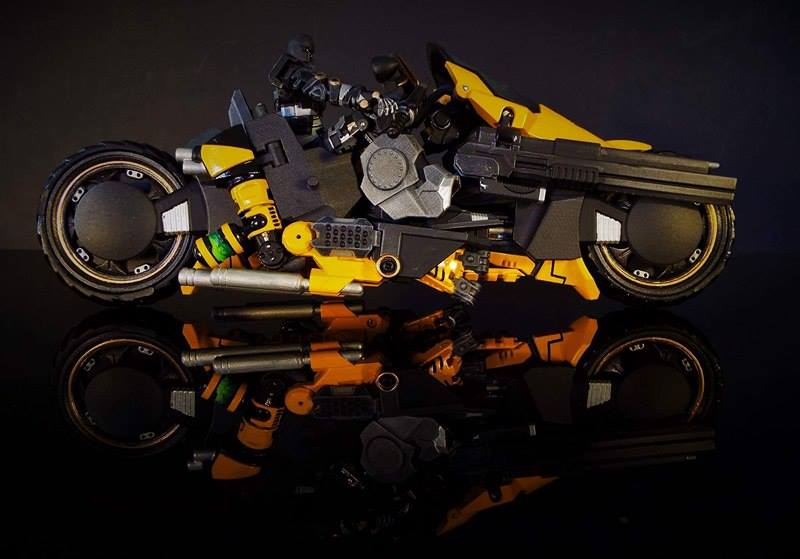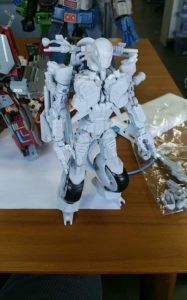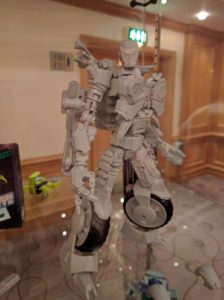I think we are at a great part of our campaign where we can discuss a few things with everyone and give a little info as we have said that we will do our best to be open and honest with our followers.
It has been brought up a few times and in a few places about doing a video or a transformation video or giving the figure to someone to do a review of it for on line viewing. At this stage of the game we need to look at prototypes, samples, and test shots to let everyone know exactly what they are getting and seeing at any given stage of the manufacturing game.
Prototype – this is the very first fully 3-dimensional version of what you are considering on creating. This is used to understand the functionality of the item and to get a feel for the item in the real world. In the past, prototypes were made from all kinds of materials, including styrene, wood, soap, simple resin castings and any other odds and ends that can be found and used in creating something. There was a real profession involved in this and had many experts in this field who did nothing but create prototypes in any given genre, be it toys or anything else that requires functionality to be tested. In todays world of 3D creating and scanning it has kind of changed this profession and created a new one of digital 3D. Now once an item is done in 3D we can see what it may look like using a render but that still does not give us a real-world view and so we use these 3D computer versions to print a resin copy for a first prototype. This is usually completely made of resin and is very fragile. The resin copy is used to check things like scale and functionality and in the instance of a transforming figure, see if it will even work to get into both modes. At this state, the figure is very easy to break and any pressure in the wrong area can fracture the resin. Because of this joints can’t be tight or anywhere near where they would on a production figure. Rarely in my last 5 years of handing resin prototypes have I come across one that has not been broken at some point. You can see these on display a lot of the time at shows and they will have globs of glue on them, blue tack, and many other sticky items on them just to keep them standing in place. Many companies will use the original prototype for first product images as it is a very good way of establishing things like scale. Resin is cast or printed in a translucent color or in greys most of the time but usually prototypes at this stage are all painted grey so that you can view things like detail on the surfaces of the item in question.
Sample – after everything on the prototype has been checked and is where it needs to be then the factory will take the prototype and create a mold. This is a huge process in itself and uses both the resin prototype and the 3D model and will carve out large blocks of metal with all the individual parts needed to create your figure. Molds can be large or small but the process is the most expensive and time consuming part of the entire manufacturing process and there is a lot of steps involved in getting this procedure all correct. This is where the sample comes into play. When the first completing of the molding is done the factory will run the mold to test it. The Factory will then assemble all the pieces together and you have a T1 sample or a TEST-1. The T1 sample is gone over in great detail and checked and rechecked. This T1 sample will be loose, won’t fit right and will have many issues at this stage of the game. The plastic used at this stage is pretty much scraps or useless pieces in an effort to keep costs down. No need to use proper colors at this stage and that is why you see many samples in various colors. Once all the areas that need to be tweaked are recorded then it is given once again to the molders and the molds are modified to establish these changes. Once the modifying is done, another run of plastic is done to check again to see if the errors are rectified. This process can happen two, three or 4 times depending on how good the factory is and how good their mold creator is. These samples would be labeled at T1, T2, T3 and so on. By the time you are on T3 then the factory should also be testing plastic colors at the same time and so at this stage you will see samples that are in the correct colors at times but without paint and still may have small tweaks needed in the mold to get a perfect fit in parts. The final stage of the samples is to finalize plastic color and paint applications.
Once the sample portion is completed we move into test shots. Test shots are completed in the molding process and are now just finalizing on paint applications. At this point you really can’t make any more changes to the mold. Now you would also be testing the packaging as well. All the test shot pieces would have paint applications and normally this is what would get into the hands of reviewers. Some companies can also hand out T4 or T5 Samples to reviewers and much of the time this can be seen in reviews as loose figures or maybe still having issues with actual fit and finish.
Currently what Mayhem Mekanics has on hand is a working prototype. This means that at this stage we have established that everything works and the figure looks decent on a whole but the figure that we have is not meant to be handled a lot, especially by people who are unsure or who have not handled this kind of figure in the past. Instead of only displaying a grey sample, we asked a professional painter to give this sample some life by applying our color scheme to the sample to give it an even closer real world look to it. Because of the fragile nature of the figure at this time, even shipping it out is risky as items breaking in international delivery is fairly common. Because of this doing an actual review of the figure is not recommended and if you attempted to transform a sample like this on camera, it would come across as having to handle it with kid gloves, something that we all know is not always done in our community. This does not imply at all that the final will be fragile or will require a light hand for transforming but just due to the nature of the materials used at this stage, breakage is fairly common.
We hope this helps in clearing up a few things not only about where our figure is currently at in the entire process but why we have had to make some of the choices we have made regarding showing the sample we have on hand. If you do have any questions or would like to know more about any of this process, please let us know and we will do what we can to communicate this to you.
Thanks for your continued support and we hope everyone becomes a Bastard.
tinyurl.com/unrust



